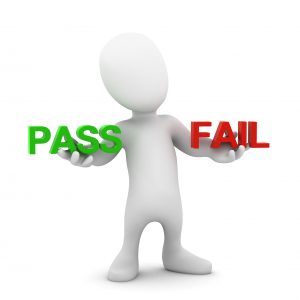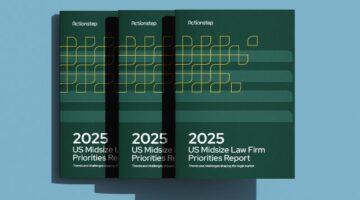
(Image via Getty)
As has been reported in a number of venues (including on ATL last week by Kathryn Rubino), bar-passage rates in many states are looking better this fall than last fall. Although large jurisdictions like California, New York, and Texas have yet to report their results, an aggregate national improvement in passage rates this year is likely given that we already know that 2019 average national performance on the multistate, multiple-choice component of the bar exam (a component which is used across the country and which in many states also serves as the baseline to which the essay or performance-exam scores are scaled) improved compared to 2018. And results so far from large states — small states with a fewer takers are less likely to representative of national trends — like Illinois and Florida seem to bear out these expectations.
Indeed, in some ways, the bar-passage percentages being reported by states so far this year may actually understate the true improvement in bar outcomes, since in the 30 or so states that have adopted the Uniform Bar Exam (UBE) a taker is reported as having failed if his score doesn’t meet the passing threshold in the state in which he physically took the UBE, even if he plans to and does successfully transfer his UBE score to another state with a lower UBE-passing threshold.

Paying for Law School in 2025: A Straight-Talk Playbook
Juno has consistently secured the best private loan deals for students at the Top MBA programs since 2018—now they’re bringing that same offer to law students, at no cost. Students can check their personalized offers at juno.us/atl This article is for general information only and is not personal financial advice.
For example, if someone sits for the UBE in Illinois and gets a 263, she is listed by Illinois as having failed because Illinois’ UBE cut score is 266, even if her plan had all along been to use her UBE score to be admitted in Minnesota, where the cut score is 260, and she took the UBE in Chicago rather than Minneapolis simply for reasons of convenience. Indeed, because it should not matter where one takes the UBE — that’s the whole point of the UBE — the ABA reports on bar passage at each school, the data for which is not collected until February of the next year (by which time we can know if someone actually did transfer a UBE score to a state other than the one where the UBE was taken), should list such a person as having passed rather than failed. This is especially true now (since this summer) that the ABA’s bar-passage standard for law school accreditation does not look to “first-time” success at all, but rather to “ultimate” success (that is, passage within two years of law school graduation). First-time pass numbers have no regulatory relevance, but are publicly reported simply for consumer benefit. And since where people take the UBE may be irrelevant to where they seek to practice, consumers may be misled rather than informed if the hypothetical Chicago UBE taker described above is listed as having failed rather than passed. Since I’m talking about the May 2019 changes in ABA bar-passage standards, let me mention another underdiscussed aspect — the apparent requirement that law schools disclose bar-passage statistics by race, ethnicity, and gender as well as in the aggregate. Some states have historically made public bar-pass rata on an ethnicity-by-ethnicity basis statewide, but not for each law school. In interpreting such school-specific data, consumers should be careful to realize that at some law schools, the number of exam takers in some underrepresented ethnic or racial groups may be too small over a one- or two-year period to generate any statistically significant inferences.
Even though results at the national level this year will be better than for the July 2018 exam, I would not go so far as Ms. Rubino did when she wrote that this year’s results so far “actually look impressive.” July 2018 results were abysmal, and July 2019 results may take us back, roughly speaking, to where we were nationally in 2017, which itself was quite a poor year by historical standards. I am speaking here in broad generalities — many law schools have had bar pass rates that have held up quite well; indeed, at the University of Illinois, we have been lucky enough over the past four years to see pass rates higher than our (already strong) historical averages. But if we are looking at all law schools throughout the country, and if the baseline is not 2018, but rather 2012 or 2013, then we are still far away from “normalcy.”
Still, any improvement is to be welcomed, and it behooves us to think about what accounts for (what I hope is the beginning of a sustained) national improvement in pass rates. A number of factors might be responsible for this year’s uptick. First, the reduction in law school class size might mean fewer people are graduating law schools who lack the academic skills to pass a bar exam. Certainly a decrease in the size of graduating law school classes seems to be the biggest factor driving the improved job placement statistics we have seen for the classes graduating in 2017 and 2018. (Again, I am speaking in the national aggregate here; a particular law school’s dramatic improvement or small decline in placement success might be attributed to school-specific factors.) That is to say, a right-sizing between supply and demand for new lawyers has helped boost employment rates.
With regard to bar passage, it might be that law schools (for better or worse) are taking fewer chances on admitting people who might lack the academic preparation for law school and bar passage success (or perhaps schools are more actively ushering such students out after the 1L year so that these students never graduate.) It is hard to know how powerful this explanation is, since even if we can observe that law schools have improved the LSAT scores and college GPAs recorded at the 25th percentile of their entering classes (and students with scores and grades in the bottom quartile are thought to be most academically at risk within any law school), the 25th percentile numbers don’t tell us what the distributional tail — that is, the makeup of the people within the bottom quartile — looks like.

Inside The Minds Working At US Midsize Law Firms: 2025 Priorities Revealed
Midsize firms want smarter tech, not more. Our 2025 industry report shows how the right tools—and strategy—can drive growth, efficiency, and better client outcomes.
A second explanation is that law schools are doing a better job, whether by tweaking their first-year curricula, adding remedial classes for students most at risk of bar failure, or (even more simply) by incorporating more multiple-choice or closed-book (or both) components into their assessment practices.
My guess is that both of these factors are playing a role. But it might also be that the lion’s share of the credit goes to the 2019 graduates themselves, and the seriousness with which they studied for the bar exam. While law school grades can be a significant predictor of bar success at many law schools, even people who did not fare well on law school exams can very often study hard for and succeed on the bar exam itself. Indeed, my anecdotal sense is that, for many good law schools at least, bar-prep ethic more than any other single variable might help explain who happens to fail the exam.
Let’s hope the improvement trend around the country continues in 2020 and a year from now we are trying to figure out what explains the upswing rather than trying to understand any backslide.
 Vikram Amar is the Dean of the University of Illinois College of Law, where he also serves the Iwan Foundation Professor of Law. His primary fields of teaching and study are constitutional law, federal courts, and civil and criminal procedure. A fuller bio and CV can be found at https://www.law.illinois.edu/faculty/profile/VikramAmar, and he can be reached at [email protected].
Vikram Amar is the Dean of the University of Illinois College of Law, where he also serves the Iwan Foundation Professor of Law. His primary fields of teaching and study are constitutional law, federal courts, and civil and criminal procedure. A fuller bio and CV can be found at https://www.law.illinois.edu/faculty/profile/VikramAmar, and he can be reached at [email protected].